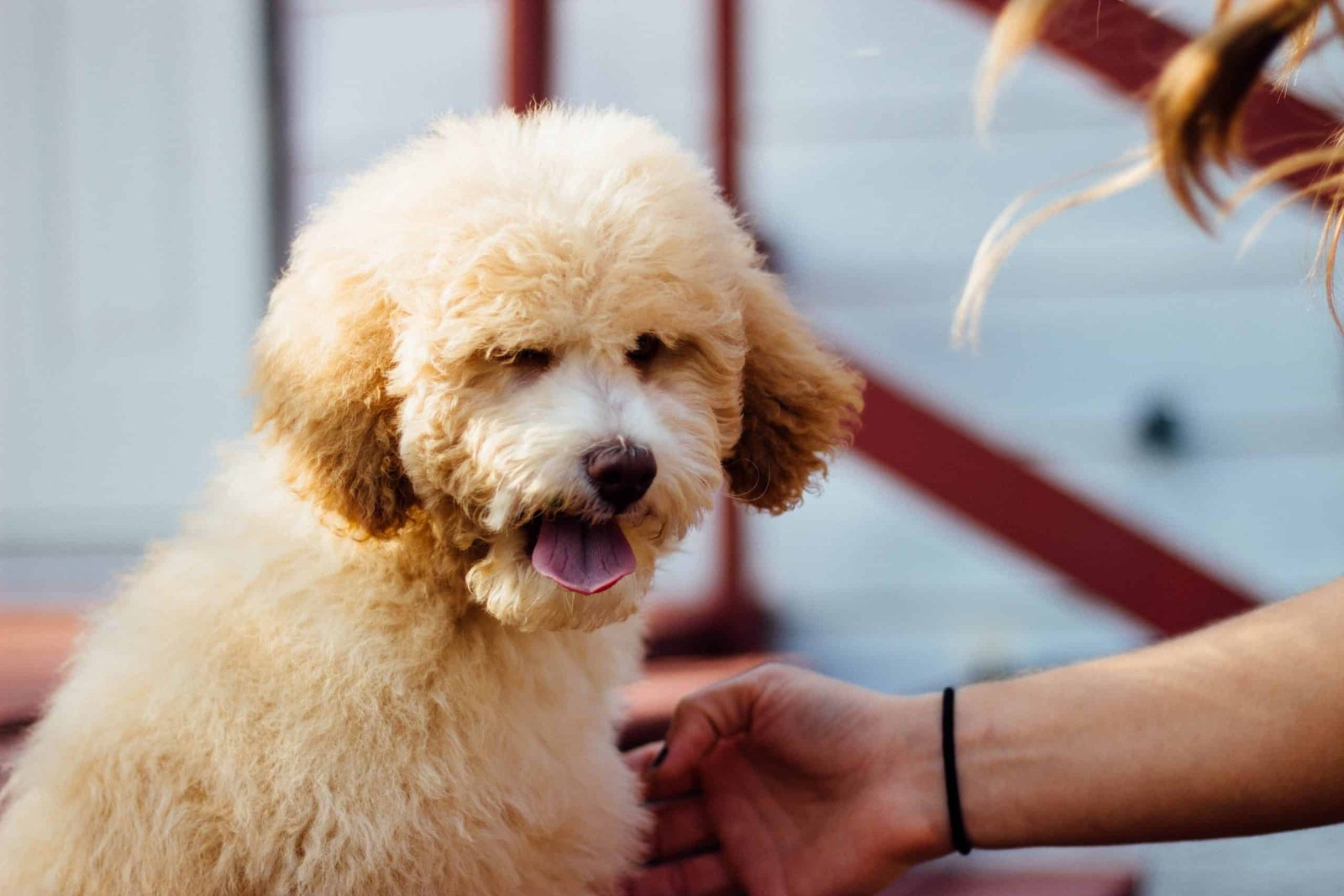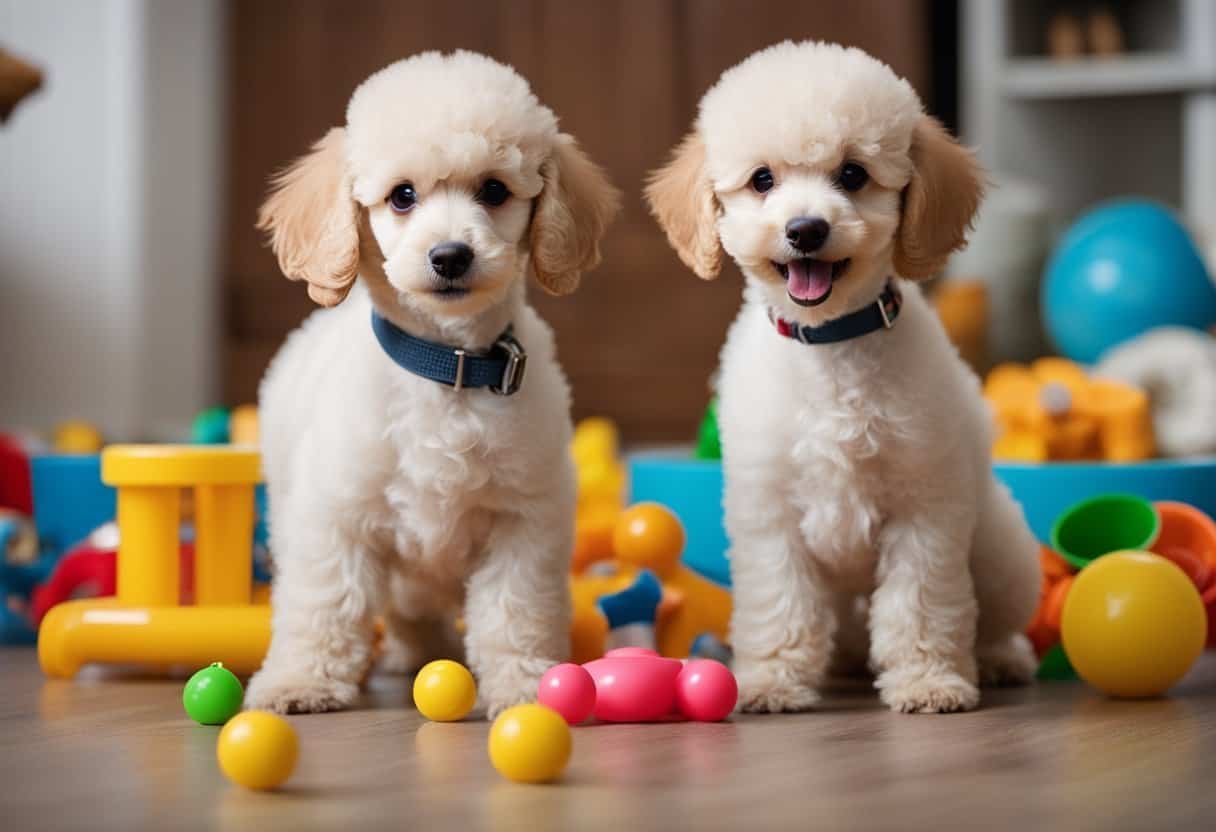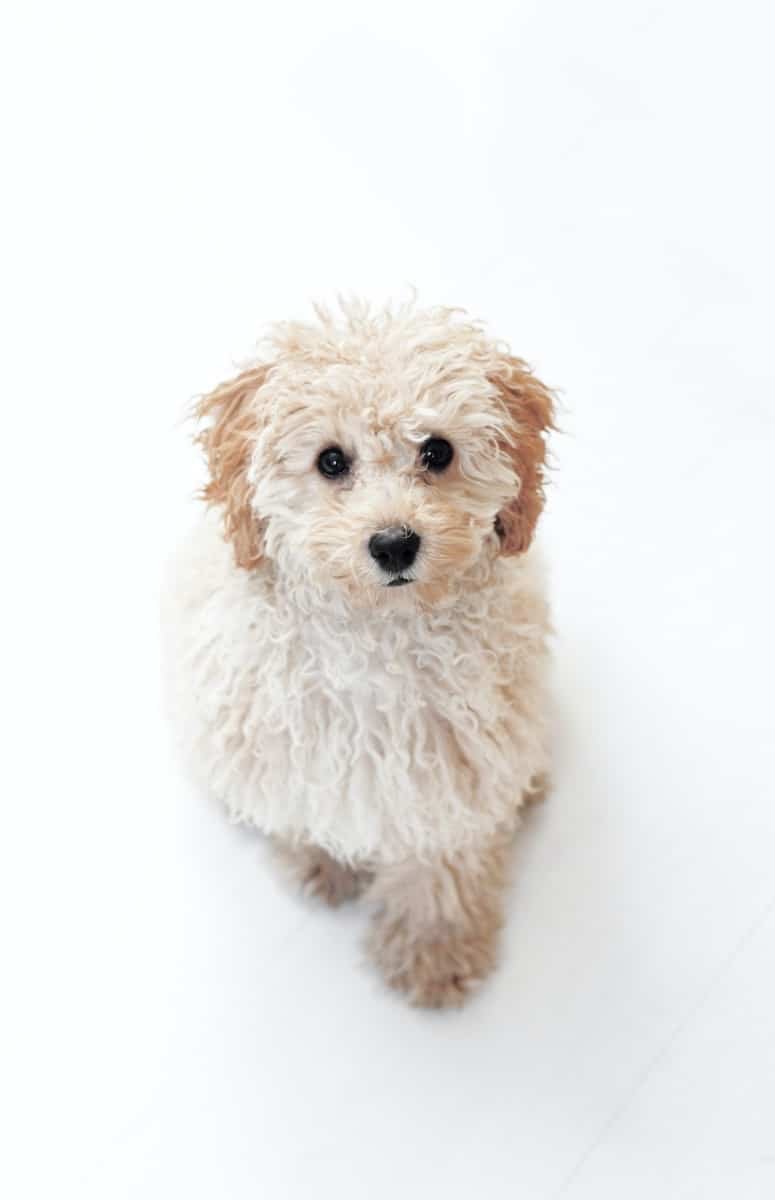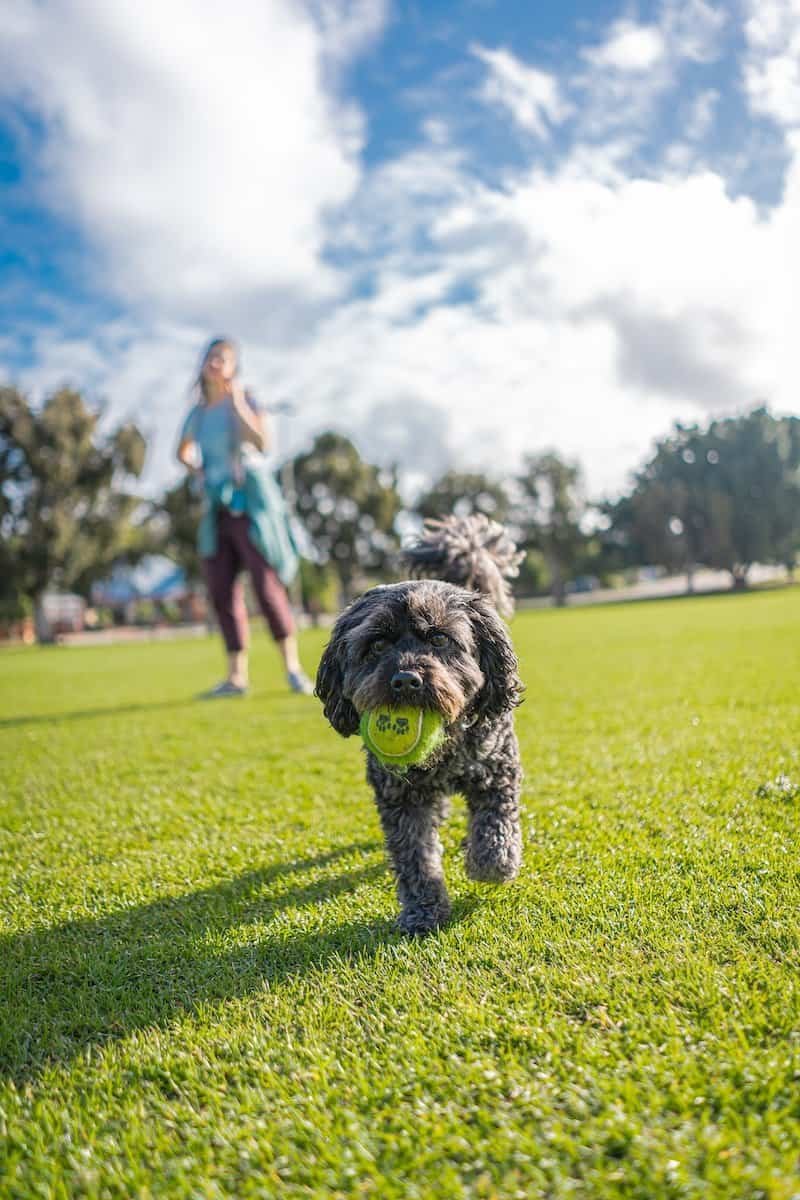
Poodles are highly intelligent, energetic, and sociable dogs, making them one of the most popular breeds worldwide. They come in various sizes – Standard, Miniature, and Toy – and are known for their curly, hypoallergenic coats. Training a Poodle can be both rewarding and challenging. As a veterinarian, I have compiled this comprehensive guide to provide you with accurate and up-to-date information on training your Poodle effectively.
Understanding Your Poodle’s Temperament
1.1 Intelligence
Poodles are known for their exceptional intelligence, ranking second only to the Border Collie. This intelligence makes them quick learners and capable of understanding complex commands.
To make the most of their intelligence, it’s important to use positive reinforcement when training your poodle. Rewarding desired behaviors with praise and treats will help reinforce those behaviors and keep your pup motivated to learn.
Related Reading: Local Poodle Rescue Organizations – Find Dogs in Your Area
Related Reading: Rescue Poodles: A Complete Guide
Related Reading: Rescue Dogs: A Complete Guide
Related Reading: Poodle Rescue Guide – Adopting Understanding Rescue Dogs
Related Reading: Essential Puppy Training Tips for Poodles – Complete Owner’s Guide
Related Reading: Dog Training Rescue: A Complete Guide
Related Reading: Poodle Intelligence Training – Unlock Your Dog’s Potential
Related Reading: Dogs For Training: A Complete Guide
You should also try to keep training sessions short but consistent. Poodles have an impressive attention span, so longer sessions can be effective, but it is important to keep them focused.
1.2 Trainability
Intelligence helps Poodles be highly trainable. However, they can also be stubborn, which means consistency and patience are crucial when training.
Encouragement and positive reinforcement can go a long way in training Poodles. Positive reinforcement helps build trust between you and your pet, which leads to better results. Use treats, toys, verbal praise, or other rewards when the pup does something correctly.
Poodles are eager to please their owners and thrive when given responsibilities. To make sure they stay focused on tasks, keep them engaged with puzzles and other stimulating activities.
1.3 Socialization Needs
Poodles are social dogs, and early socialization is crucial to prevent them from becoming shy or aggressive towards strangers and other animals.
It’s especially important to introduce your pup to as many people, places and things as possible during their first few months of life. Take them on outings to the park or beach, have visitors come over, and expose them to various sounds and smells. The more they experience in their early stage of life, the more they will develop into confident, well-rounded adults.
In addition, Poodles need to be taught basic commands like “sit,” “stay,” and “come.” These commands will help you control your pup in public settings and keep them safe from harm.
1.4 Energy
Poodles are known for their high energy levels, which means they need plenty of exercise. Regular walks and playtime will help your pup stay healthy and active.
For those with an especially energetic poodle, you may want to look into agility classes or doggy daycare. These activities can provide mental stimulation and physical exercise.
Positive Reinforcement Training
2.1 Importance of Positive Reinforcement
Positive reinforcement involves rewarding your dog for desired behaviors, which increases the likelihood that they will repeat them. This approach is essential for Poodles, as it strengthens the bond between you and your dog and promotes a healthy learning environment.
2.1.2 Benefits of Positive Reinforcement
Positive reinforcement training allows you to communicate with your Poodle in a gentle and effective way, teaching them how to behave without the need for punishment. This method will help build trust between you and your pet while reinforcing learned behaviors. As an added bonus, positive reinforcement helps keep your Poodle’s enthusiasm high during the learning process, which makes training more enjoyable for both you and your pup.
2.2 Tools for Positive Reinforcement Training
Use treats, toys, and praise as rewards for desired behaviors. Choose high-value rewards that your Poodle is particularly interested in, such as small pieces of chicken or a favorite toy.
Use verbal cues when working with your Poodle. This will help them understand what you want them to do and cement the desired behavior. Use cues like sit, stay, come, and down to direct their behavior during training sessions.
Make sure you provide positive reinforcement immediately after the Poodle performs a desired behavior or follows a command. This reinforces the behavior quickly and helps build trust between you and your pup.
2.3 Avoiding Negative Training Techniques
Avoid using punishment or negative reinforcement, as these techniques can damage your Poodle’s trust and confidence, leading to fear and anxiety.
Instead, use positive reinforcement techniques to reward good behavior. For example, if your Poodle does something you like, give them a treat or attention. This will help reinforce the behavior and make your Poodle more likely to repeat it in the future.
It is also important to be consistent with your training. Be sure to use the same words, commands and hand gestures each time. This will help your pup recognize and remember the commands.
Finally, be patient when training your Poodle. Dogs learn at their own pace, so it’s important to be consistent and provide plenty of positive reinforcement when working with your pup.
Basic Commands and Obedience Training
Teaching your poodle basic commands is an important and necessary step in cultivating a well-behaved pet. Start with these essential commands:
3.1 Sit
The “sit” command is a fundamental obedience skill that every dog should learn. To teach your Poodle to sit, follow these steps:
- Hold a treat near your poodle’s nose.
- Slowly move the treat upwards, allowing your dog’s head to follow.
- As your Poodle’s head goes up, their bottom should naturally go down into a sitting position.
- Once your dog sits, say “sit” and reward them with the treat.
- Repeat this process multiple times, gradually increasing the time between the command and the reward.
3.2 Stay
The “stay” command teaches your Poodle to remain in one place, even when distractions are present. To teach “stay,” follow these steps:
- Put your Poodle in a “sit” or “down” position.
- Stand in front of your dog and show your palm as a visual cue while saying “stay.”
- Wait a beat, and reward your dog for staying in place so well.
- Gradually increase the duration of the “stay” and the distance between you and your dog.
- Practice “stay” in different locations and with various distractions.
3.3 Come
The “come” command ensures your Poodle comes to you when called, which is crucial for safety. To teach “come,” follow these steps:
- Attach a long leash to your Poodle’s collar.
- Walk away from your dog and then call their name followed by “come.”
- Use the leash to guide your dog towards you if needed gently.
- Once your Poodle reaches you, reward them with treats and praise.
- Practice the “come” command in different environments and with increasing distractions.
3.4 Down
The “down” command teaches your Poodle to lie down on command. To teach “down,” follow these steps:
- Hold a treat in your hand and let your poodle sniff it.
- Move the treat downwards, guiding your dog’s head towards the floor.
- As your Poodle’s front legs bend, slide the treat along the ground, encouraging them to lie down.
- When your dog is in the down position, say “down” and reward them with the treat.
- Repeat the process, gradually increasing the time between the command and the reward.
3.5 Heel
The “heel” command teaches your Poodle to walk at your side without pulling on the leash. To teach “heel,” follow these steps:
- Start with your Poodle on a leash and have them sit at your left side.
- Hold a treat in your left hand and let your dog sniff it.
- Begin walking forward while saying “heel” and keeping the treat at your dog’s nose level.
- If your Poodle stays at your side, reward them with the treat after a few steps.
- Gradually increase the distance between rewards, ensuring your dog remains in the heel position.
3.6 Leave It
The “leave it” command helps prevent your Poodle from picking up or chewing on unwanted items. To teach “leave it,” follow these steps:
- Hold a treat in each hand.
- Show your Poodle one treat and say “leave it.”
- Close your hand around the treat, hiding it from view.
- When your dog stops trying to get the hidden treat, say “yes” or “good” and reward them with the treat from your other hand.
- Practice this command with various objects and in different locations.
- Socialization and Exposure Training
Socialization
Early socialization is crucial to ensure your Poodle is comfortable and confident in various situations.
4.1 Meeting New People
Expose your Poodle to a diverse range of people, including men, women, children, and individuals wearing hats, sunglasses, or carrying bags. Reward your Poodle for calm behavior and allow them to approach new people at their own pace.
Explain to visitors what you expect from your Poodle and ask them not to approach or touch your pup until they have been given verbal permission. Ask visitors to sit down, then give your dog the cue to come over and sniff them if he is interested.
Encourage polite behavior when meeting new people with treats or praise. Teach your dog cues such as “sit” and “shake” to ensure they remain calm.
4.2 Introducing Other Pets
Introduce your Poodle to other dogs, cats, and small animals in a controlled environment. Ensure both animals are on-leash and reward positive interactions. Gradually increase the time spent together while monitoring their behavior.
4.3 Experiencing New Environments
Take your Poodle to various environments, such as parks, pet stores, and busy streets. Expose them to different sounds, surfaces, and situations to help them become more adaptable and confident.
Crate Training
5.1 Benefits of Crate Training
Crate training provides your Poodle with a safe and secure space to relax. It also aids in house training and prevents destructive behavior when left alone.
The most obvious benefit of crate training your Poodle is that it provides them with a safe and comfortable space that they can call their own. It gives them a place to retreat to when they are feeling overwhelmed or stressed out. The crate acts as a den for your pet, providing them with security, safety and familiarity. This helps to reduce anxiety and stress in your Poodle, which can have long-term benefits on their health and wellbeing.
Crate training also helps to prevent destructive behavior when left alone or during travel. Dogs can be triggered to chew, dig or bark in unfamiliar environments, but having a familiar space to retreat to can make them feel more secure and less likely to act out. Crate training also makes it easier for owners to house train their pet as dogs will naturally avoid soiling the area they sleep in.
5.2 Choosing the Right Crate
Select a crate large enough for your Poodle to stand up, turn around, and lie down comfortably. Ensure it has proper ventilation and a secure door.
If your Poodle is still a puppy, you should purchase a divider for the crate. This will allow you to adjust the size of the crate as your pup grows, without having to buy a larger model too soon.
When introducing your Poodle to the crate, make sure that you do it positively. Offer treats and praise when they enter the crate and stay for a few minutes. With time and patience, your dog will learn to enjoy spending time in the crate.
5.3 Crate Training Techniques
Introduce your Poodle to the crate gradually, using treats and praise to create a positive association. Begin by leaving your dog in the crate for short periods while you’re at home and gradually increase the duration as they become comfortable.
1. Begin by making the crate a comfortable and inviting space. Place a blanket or pillow inside, along with some of your Poodle’s favorite toys. Keep the door open and allow them to explore the crate at their own pace.
2. Allow your Poodle to become accustomed to the crate before you attempt any formal training techniques. Give them treats when they enter it on their own and reward them with praise when they stay inside.
3. Once your Poodle is comfortable in the crate, you can begin to introduce commands such as “go to bed” or “crate up” to show that it is time for them to enter the crate.
The most important part of crate training your Poodle is to ensure that it is a positive experience. Start by placing their crate in an area with minimal distractions and make sure that it is large enough for them to stand up, turn around and lie down comfortably. Place treats and toys inside the crate to encourage them to explore, but don’t force them inside. Let them enter the crate on their own and reward them with treats or praise when they remain inside. With patience and consistency, your Poodle will soon feel comfortable in the crate and look forward to spending time in it.
4. Finally, gradually increase the length of time that your Poodle spends in the crate. This will help them understand that spending time in their crate is a normal part of daily life.
Crate training can be an invaluable tool for pet owners who want to ensure their Poodle’s safety and comfort. With patience and consistency, your dog will soon learn to love their crate and view it as their own special space.
House Training
6.1 Establishing a Routine
Establish a consistent routine for feeding, walking, and playtime. This routine helps your Poodle learn when to expect bathroom breaks, reducing the chance of accidents.
Start by introducing a set mealtime and sticking to it. This helps your Poodle understand when meals will be received, which can minimize begging behaviors. Additionally, ensure that your Poodle is getting plenty of exercise. A daily walk or run provides both physical and mental stimulation for your pup.
When playtime arrives, keep the activities interesting for your pup. Teach new commands , play a game of fetch, or take them to the dog park.
6.2 Rewarding Good Behavior
Reward your Poodle with treats and praise when they eliminate outdoors. This positive reinforcement encourages them to continue using the designated area.
You should also reward your Poodle for other good behaviors like sitting, staying or coming when called. This will help to reinforce the desired behavior and create a bond between you and your poodle.
When rewarding with food, use small treats and be sure not to overfeed your pup. If you’re using verbal praise, make it genuine and enthusiastic so that your pup knows it’s deserved.
6.3 Dealing with Accidents
If your Poodle has an accident indoors, clean the area thoroughly to remove any lingering odors. Avoid punishing your dog, as this can create fear and anxiety.
6.4. Setting Up an Accident Zone.
Although they can be trained to go outside, Poodles may have occasional accidents in the house. Designate a specific accident zone to help limit messes if your pup has an accident indoors. Place newspapers or puppy pads in the area and take your Poodle there each time you expect them to go potty.
6.5 Supervise and Potty Train
Supervise your Poodle when they are not in their crate or kennel. This helps you learn their potty cues and ensures that they do not have any accidents in the house. If possible, try to take your pup outside every two hours to allow them to use the restroom.
In addition, use a designated potty spot for your pup and take them there each time they need to go. When they finish their business, reward them with treats or praise. Over time, your Poodle will understand that this is where they are expected to go when nature calls.
Leash Training
7.1 Importance of Leash Training
Leash training ensures your Poodle walks calmly on a leash without pulling, lunging, or weaving. This skill is essential for safety and makes walks more enjoyable for both you and your dog.
A well-trained Poodle should walk alongside you without pulling or tugging on the leash. Start leash training by teaching your Poodle to respond to basic commands like “sit” and “stay,” and then introduce the leash. You can start indoors in a quiet space or outside in an enclosed area with few distractions.
When introducing the leash, make sure your Poodle is comfortable wearing it and associate the leash with positive rewards. Never use the leash to punish your pup, as this could create fear and anxiety.
7.2 Choosing the Right Leash and Collar
Select a comfortable collar and a sturdy leash. A 6-foot leash provides enough freedom while maintaining control. Avoid retractable leashes, as they can encourage pulling behavior.
When selecting a collar, make sure it is the right size and fit. It should be snug enough that it doesn’t slip over your pup’s head, but not too tight that it irritates their neck.
Leather collars provide more control, as they are less flexible than nylon ones. However, leather can break when tugged too hard. In addition, make sure the collar isn’t too heavy for your Poodle.
7.3 Leash Training Tips
• Start in a quiet area with minimal distractions.
• Reward your pup with treats and verbal praise when they respond to commands on the leash.
• If your pup pulls, stop and wait until they return to a calm state before continuing.
7.4 Techniques for Leash Training
Practice loose-leash walking by rewarding your Poodle when they walk calmly by your side. If your dog pulls, stop walking and wait for them to return to your side before continuing. Consistency is crucial for successful leash training.
Dealing with Common Poodle Behavioral Issues
8.1 Separation Anxiety
Poodles can suffer from separation anxiety, resulting in destructive behavior when left alone. To reduce anxiety, create a consistent routine, accumulate your dog’s time alone, and provide mental stimulation with toys and puzzles.
When introducing a new routine, start with small changes and gradually increase the time your poodle spends alone. Give them plenty of exercise to tire them out and provide companionship when they are home.
Provide mental stimulation while you are away by giving your dog puzzles or food-dispensing toys. These will keep them busy and distracted from their loneliness. Use positive reinforcement during training to help curb any anxious behavior.
8.2 Excessive Barking
Poodles may bark excessively because of boredom, fear, or territorial behavior. Identify the cause of barking and address it accordingly. Train your Poodle to respond to a “quiet” command and reward them for ceasing to bark.
For territorial barking, teach your Poodle to recognize a variety of people and animals. This will help to desensitize them and reduce the amount of barking. If boredom is the cause, provide plenty of interactive toys and activities for the Poodle to enjoy.
Regular exercise can also be beneficial; a tired poodle is less likely to bark excessively. Incorporate mental exercises such as training and play into their exercise routine to keep them stimulated.
8.3 Jumping Up
Teach your Poodle that jumping up is an unacceptable behavior by ignoring them when they jump and rewarding them when they remain on all fours. Consistently reinforce this rule with all family members and visitors.
Start by teaching your Poodle to sit and stay. When they jump up, ignore them and ask them to sit. Praise them when they respond correctly. If they don’t, help guide them into the correct position and reward them with a treat or verbal praise.
During interactions with other people, make sure everyone is following the same rule about jumping. Have family members and guests reward your pup with treats or verbal praise when they stay on all fours.
8.4 Resource Guarding
Resource guarding occurs when a dog becomes possessive over food, toys, or space. Prevent this behavior by teaching your Poodle to “drop it” and “leave it,” and practice exchanging high-value items for treats.
When your Poodle has a toy or item, he refuses to give up, do not try to take it away. Instead, offer him a treat and encourage him to drop the object. Praise him for dropping the object, then give him the treat. This is teaching the dog that exchanging an item he is guarding for something even better (treats) is a good thing.
Advanced Training and Dog Sports
Poodles excel in various dog sports and advanced training activities because of their intelligence and athleticism. These activities provide mental and physical stimulation, further strengthening the bond between you and your Poodle.
Advanced training and dog sports for Poodles can include obedience, agility, rally obedience, fly ball, tracking and scent work. Obedience includes teaching your Poodle to respond to verbal commands such as sit, stay and come when called. Agility involves teaching your Poodle to navigate an obstacle course with jumps, ramps and tunnels. Rally obedience tests your Poodle’s ability to work with you as a team, while fly ball and Frisbee require your pup to use their speed and strength. Tracking and scent work involve teaching your Poodle to find an object or follow a scent trail.
If you’re interested in pursuing advanced training or dog sports for your Poodle, contact a dog trainer or join a local club to get started.
9.1 Agility Training
Agility is a popular dog sport that involves navigating a timed obstacle course. Poodles often excel in agility because of their athleticism and problem-solving abilities. Start with basic obstacles and gradually introduce more complex ones as your dog gains confidence.
Before starting agility training, make sure your poodle is in good physical condition. Start with brief sessions that are fun and rewarding for your poodle. Use treats, toys, and verbal praise to encourage your dog’s successes.
When introducing a new obstacle, start with the easiest version of it first. Break down each obstacle into simple steps and reward each successful step until your poodle has mastered the obstacle.
When training for agility, remember to be patient and encouraging. If your Poodle is struggling with an obstacle, don’t force them. Give them breaks from the course and come back when they are ready. With consistent practice, your pup will become a master of the obstacles in no time!
9.2 Obedience Trials
Obedience trials test a dog’s ability to perform a series of commands and exercises accurately and consistently. Participating in obedience trials can further enhance your Poodle’s training and provide an opportunity to showcase their skills.
When training your Poodle for obedience trials, it is important to start with basic commands like sit, stay and come. Teaching your Poodle good manners and socialization skills is also important, as they will need to interact with people and other dogs during the trial. It is best to begin training in a familiar environment rather than the competition venue to ensure a relaxed atmosphere.
Your Poodle should also be comfortable being handled by the judge and strangers.
Practice basic commands to ensure your Poodle can perform them accurately and consistently. Gradually add more difficult exercises as your Poodle masters each one. With consistent practice, you and your pup will be ready to showcase their skills in an obedience trial!
9.3 Therapy Dog Training
Poodles’ gentle nature and intelligence make them excellent candidates for therapy dog work. Therapy dogs provide comfort and emotional support to individuals in hospitals, nursing homes, and other care facilities. To become a therapy dog, your Poodle will need to pass a certification process that assesses their temperament, obedience, and socialization skills.
When training your Poodle for therapy dog work, it’s important to start with a strong foundation in basic obedience. This should include commands such as sit, stay, come, leave it, and heel. It’s also important to work on socialization skills to ensure that your Poodle is comfortable being around people and other animals.
After establishing obedience and socialization, try practicing in various settings and with different individuals. This will help your Poodle become accustomed to the sights, sounds, and smells of a therapy dog setting. With consistent practice, you and your pup will be ready to make a difference in someone’s life as a certified therapy dog!
Summary
Training your Poodle is essential for their well-being and your enjoyment as a pet owner. A well-trained Poodle is a happier, more confident companion that can fully take part in your life. Understand your Poodle’s temperament, use positive reinforcement, and address common behavioral issues for a strong bond and lifetime of happiness with your Poodle.
Remember, patience and consistency are crucial when training any dog, including Poodles. If you have trouble or feel overwhelmed, get help from a certified dog trainer or behaviorist. They can provide guidance and support tailored to your Poodle’s specific needs and help you achieve your training goals.
Positive reinforcement is the key to successful Poodle training. Praise, treats, and playtime are all excellent rewards for good behaviors. To get your Poodle to respond quickly and consistently, be sure to reward them immediately after they do something you’ve asked of them.
It’s also important to recognize and address any behavioral issues early in order to prevent them from becoming more serious problems. With patience and consistency, you can train your poodle to be a well-mannered, obedient companion. Good luck!








